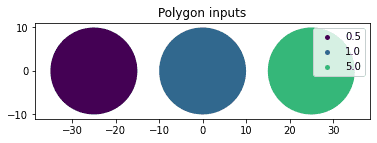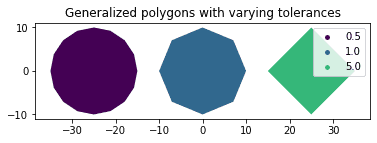ST_Generalize takes a linestring or polygon geometry column and a numeric tolerance and returns a geometry column. This function generalizes the input linestring or polygon geometry using the Douglas-Peucker algorithm with the specified tolerance. The result is the input geometry generalized to include only a subset of the original geometry's vertices. Point and multipoint geometry types are not supported as input.
The tolerance can be specified with or without a unit. When specified with a unit, the tolerance can be defined using
ST_CreateDistance or with a tuple containing a number and a unit string
(e.g., (10, "kilometers")). When specified without a unit, the tolerance can be a single value or a numeric column,
and it is assumed to be in the same units as the input geometry.
| Function | Syntax |
|---|---|
| Python | generalize(geometry, tolerance) |
| SQL | ST |
| Scala | generalize(geometry, tolerance) |
For more details, go to the GeoAnalytics Engine API reference for generalize.
Python and SQL Examples
from geoanalytics.sql import functions as ST, Point
data = [
(Point(-25,0), 0.5),
(Point(0,0), 1.0),
(Point(25,0), 5.0)
]
df = spark.createDataFrame(data, ["point", "tolerance"])
df_buffer = df.withColumn("buffer", ST.buffer("point", 10))
axes = df_buffer.st.plot(geometry="buffer", cmap_values="tolerance", is_categorical=True, \
legend=True, aspect = "equal")
axes.set_title("Polygon inputs")
result = df_buffer.select(ST.generalize("buffer", "tolerance"), "tolerance")
axes = result.st.plot( cmap_values="tolerance", is_categorical=True, legend=True, aspect = "equal")
axes.set_title("Generalized polygons with varying tolerances");

Scala examples
import com.esri.geoanalytics.geometry._
import com.esri.geoanalytics.sql.{functions => ST}
import org.apache.spark.sql.{functions => F}
case class PointRow(point: Point, tolerance: Double)
val data = Seq(PointRow(Point(-25, 0), 0.5),
PointRow(Point(0, 0), 1.0),
PointRow(Point(25, 0), 5.0))
val df = spark.createDataFrame(data)
.withColumn("buffer", ST.buffer($"point", 10))
.select(ST.generalize($"buffer", $"tolerance").alias("generalize"))
.withColumn("generalized_polygon_area", F.round(ST.area($"generalize"),3))
df.show()+--------------------+------------------------+
| generalize|generalized_polygon_area|
+--------------------+------------------------+
|{"rings":[[[-15,0...| 306.147|
|{"rings":[[[10,0]...| 282.843|
|{"rings":[[[35,0]...| 200.0|
+--------------------+------------------------+Version table
| Release | Notes |
|---|---|
1.0.0 | Python and SQL functions introduced |
1.5.0 | Scala function introduced |
1.6.0 | tolerance parameter accepts values specified with units |